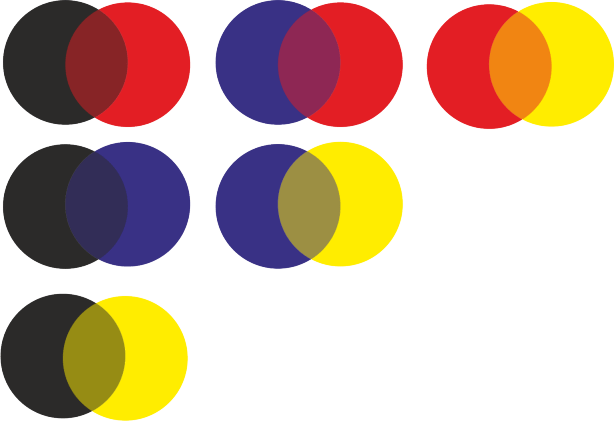The previous lessons talked about arrangements or permutations of objects. This lesson will deal with selections or combinations of objects.
Combinations
In simple words, a combination is a selection made with no regard to order of the selected objects.
To be a little more clear, let’s take an example. Suppose you have 4 different colors…

…of which you have to mix 2 (in equal proportions) to make a new color. How many new colors can be made?
Notice that mixing Blue and Red is exactly the same as mixing Red and Blue, i.e. the order does not matter.
Let’s list all the possible cases.

As you can see there are 6 new colors – Black-Blue, Black-Red, Black-Yellow, Blue-Red, Blue-Yellow, Red-Yellow.
Okay, so how do we count this in a logical way?
Let’s first state the problem in a more standard manner: “In how many ways can a selection of 2 objects be made from 4 distinct objects?” (say A, B, C and D)
Let the number of combinations be N.
Note that every selection of two particular objects (say A and B) corresponds to 2! different arrangements (AB and BA). That is, there are 2! times as many permutations as there are combinations (for the case of selecting 2 objects).
But we’ve already calculated the number of permutations of 4 objects taken 2 at a time. This equals \( {}^{4}P_2 \). Therefore, according to our logic, \( {}^{4}P_2 \) = 2! X N, or N = \( {}^{4}P_2 \)/2! = 6. Makes sense?
What if we had to select 3 objects out of 5? In this case the number of permutations will be 3! or 6 times as the number of combinations. (The 6 permutations ABC ACB BAC BCA CAB CBA correspond to the selection {A, B, C}). Therefore the number of combinations will be the number of permutations divided by 3!, which equals \( {}^{5}P_3 \)/3! = 5!/(2!3!) = 10. (These 10 selections are {A,B,C}, {A,B,D},{A,B,E},{A,C,D},{A,C,E},{A,D,E},{B,C,D},{B,C,E},{B,D,E},{C,D,E})
We can now generalize this expression for the case of selection of r objects out of n distinct objects (0 ≤ r ≤ n). The number of selections or combinations will be \( {}^{n}P_r \) / r! or \( \frac{n!}{(n-r)!r!} \). This expression is denoted as \( {}^{n}C_r \) or C(n, r) or \( n \choose r \). (We’ll stick with the first one)
Lesson Summary
The number of ways of selecting r objects out of n distinct objects is given by \( {}^{n}C_r \), which equals \( \frac{n!}{(n-r)!r!} \)
Before moving on to examples, I’ll show you one more way to arrive at the same expression for selections. See you in the next lesson.